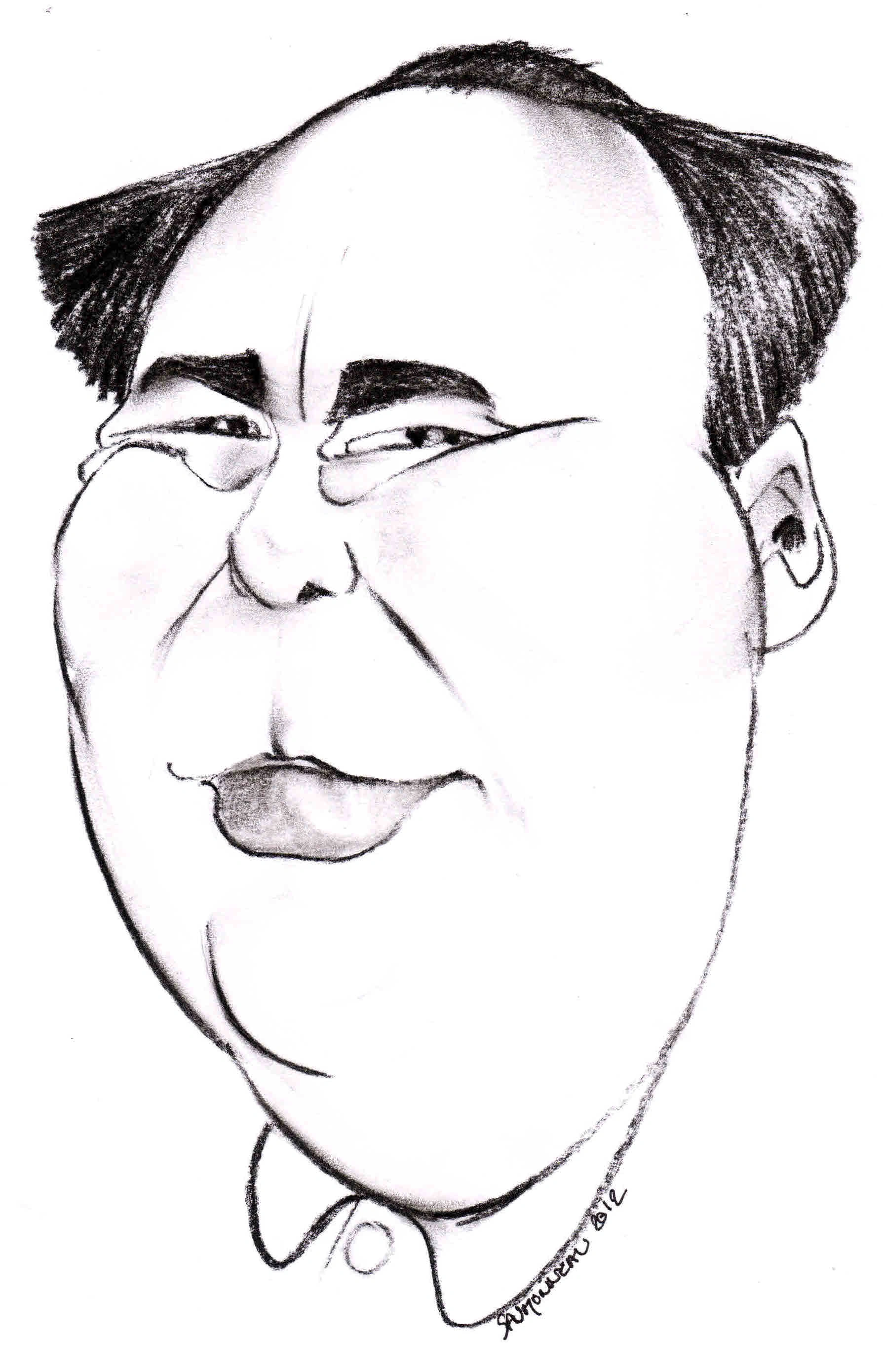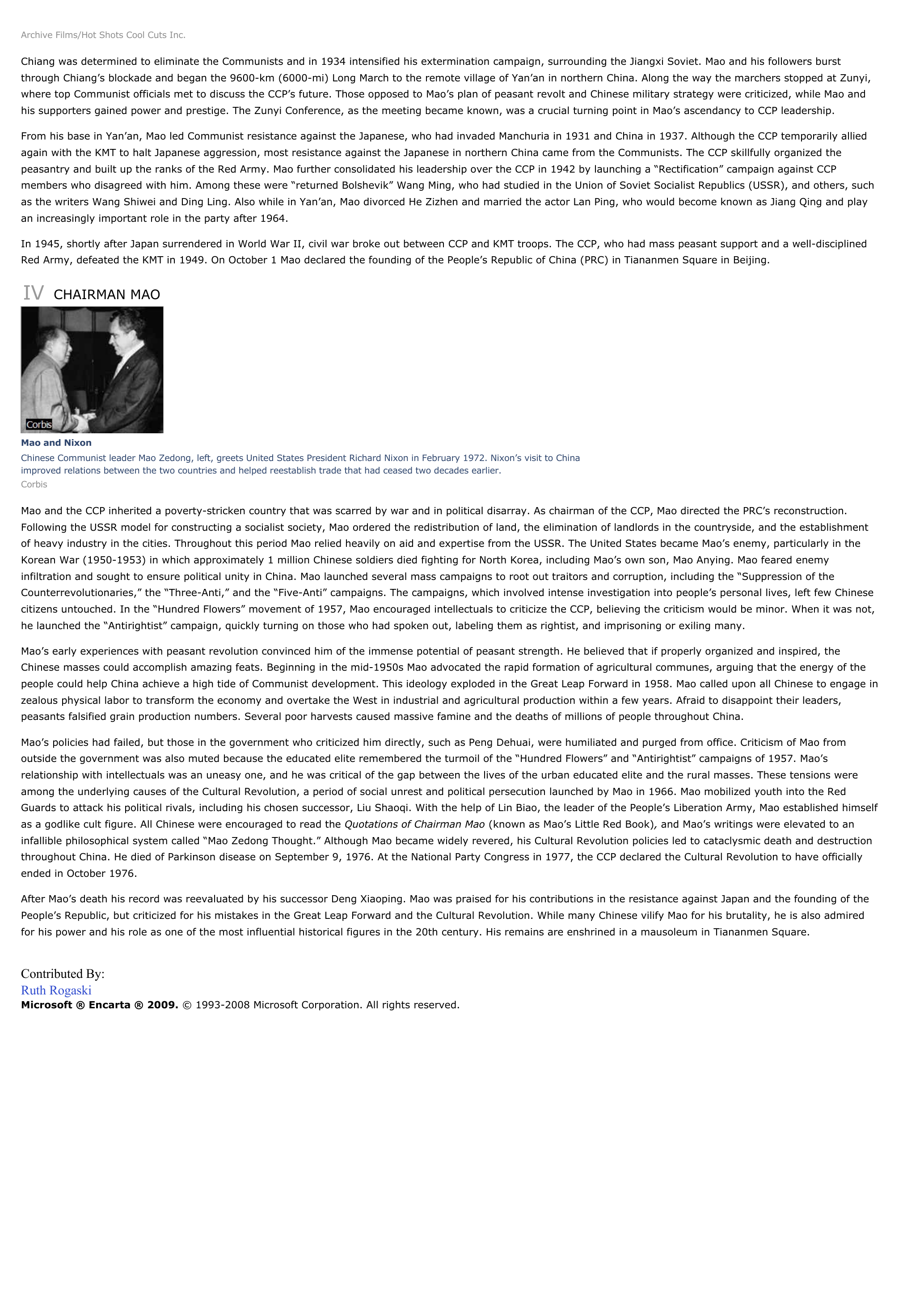Mao Zedong - history.
Publié le 26/05/2013

Extrait du document


«
Archive Films/Hot Shots Cool Cuts Inc.
Chiang was determined to eliminate the Communists and in 1934 intensified his extermination campaign, surrounding the Jiangxi Soviet.
Mao and his followers burstthrough Chiang’s blockade and began the 9600-km (6000-mi) Long March to the remote village of Yan’an in northern China.
Along the way the marchers stopped at Zunyi,where top Communist officials met to discuss the CCP’s future.
Those opposed to Mao’s plan of peasant revolt and Chinese military strategy were criticized, while Mao andhis supporters gained power and prestige.
The Zunyi Conference, as the meeting became known, was a crucial turning point in Mao’s ascendancy to CCP leadership.
From his base in Yan’an, Mao led Communist resistance against the Japanese, who had invaded Manchuria in 1931 and China in 1937.
Although the CCP temporarily alliedagain with the KMT to halt Japanese aggression, most resistance against the Japanese in northern China came from the Communists.
The CCP skillfully organized thepeasantry and built up the ranks of the Red Army.
Mao further consolidated his leadership over the CCP in 1942 by launching a “Rectification” campaign against CCPmembers who disagreed with him.
Among these were “returned Bolshevik” Wang Ming, who had studied in the Union of Soviet Socialist Republics (USSR), and others, suchas the writers Wang Shiwei and Ding Ling.
Also while in Yan’an, Mao divorced He Zizhen and married the actor Lan Ping, who would become known as Jiang Qing and playan increasingly important role in the party after 1964.
In 1945, shortly after Japan surrendered in World War II, civil war broke out between CCP and KMT troops.
The CCP, who had mass peasant support and a well-disciplinedRed Army, defeated the KMT in 1949.
On October 1 Mao declared the founding of the People’s Republic of China (PRC) in Tiananmen Square in Beijing.
IV CHAIRMAN MAO
Mao and NixonChinese Communist leader Mao Zedong, left, greets United States President Richard Nixon in February 1972.
Nixon’s visit to Chinaimproved relations between the two countries and helped reestablish trade that had ceased two decades earlier.Corbis
Mao and the CCP inherited a poverty-stricken country that was scarred by war and in political disarray.
As chairman of the CCP, Mao directed the PRC’s reconstruction.Following the USSR model for constructing a socialist society, Mao ordered the redistribution of land, the elimination of landlords in the countryside, and the establishmentof heavy industry in the cities.
Throughout this period Mao relied heavily on aid and expertise from the USSR.
The United States became Mao’s enemy, particularly in theKorean War (1950-1953) in which approximately 1 million Chinese soldiers died fighting for North Korea, including Mao’s own son, Mao Anying.
Mao feared enemyinfiltration and sought to ensure political unity in China.
Mao launched several mass campaigns to root out traitors and corruption, including the “Suppression of theCounterrevolutionaries,” the “Three-Anti,” and the “Five-Anti” campaigns.
The campaigns, which involved intense investigation into people’s personal lives, left few Chinesecitizens untouched.
In the “Hundred Flowers” movement of 1957, Mao encouraged intellectuals to criticize the CCP, believing the criticism would be minor.
When it was not,he launched the “Antirightist” campaign, quickly turning on those who had spoken out, labeling them as rightist, and imprisoning or exiling many.
Mao’s early experiences with peasant revolution convinced him of the immense potential of peasant strength.
He believed that if properly organized and inspired, theChinese masses could accomplish amazing feats.
Beginning in the mid-1950s Mao advocated the rapid formation of agricultural communes, arguing that the energy of thepeople could help China achieve a high tide of Communist development.
This ideology exploded in the Great Leap Forward in 1958.
Mao called upon all Chinese to engage inzealous physical labor to transform the economy and overtake the West in industrial and agricultural production within a few years.
Afraid to disappoint their leaders,peasants falsified grain production numbers.
Several poor harvests caused massive famine and the deaths of millions of people throughout China.
Mao’s policies had failed, but those in the government who criticized him directly, such as Peng Dehuai, were humiliated and purged from office.
Criticism of Mao fromoutside the government was also muted because the educated elite remembered the turmoil of the “Hundred Flowers” and “Antirightist” campaigns of 1957.
Mao’srelationship with intellectuals was an uneasy one, and he was critical of the gap between the lives of the urban educated elite and the rural masses.
These tensions wereamong the underlying causes of the Cultural Revolution, a period of social unrest and political persecution launched by Mao in 1966.
Mao mobilized youth into the RedGuards to attack his political rivals, including his chosen successor, Liu Shaoqi.
With the help of Lin Biao, the leader of the People’s Liberation Army, Mao established himselfas a godlike cult figure.
All Chinese were encouraged to read the Quotations of Chairman Mao (known as Mao’s Little Red Book) , and Mao’s writings were elevated to an infallible philosophical system called “Mao Zedong Thought.” Although Mao became widely revered, his Cultural Revolution policies led to cataclysmic death and destructionthroughout China.
He died of Parkinson disease on September 9, 1976.
At the National Party Congress in 1977, the CCP declared the Cultural Revolution to have officiallyended in October 1976.
After Mao’s death his record was reevaluated by his successor Deng Xiaoping.
Mao was praised for his contributions in the resistance against Japan and the founding of thePeople’s Republic, but criticized for his mistakes in the Great Leap Forward and the Cultural Revolution.
While many Chinese vilify Mao for his brutality, he is also admiredfor his power and his role as one of the most influential historical figures in the 20th century.
His remains are enshrined in a mausoleum in Tiananmen Square.
Contributed By:Ruth RogaskiMicrosoft ® Encarta ® 2009. © 1993-2008 Microsoft Corporation.
All rights reserved..
»
↓↓↓ APERÇU DU DOCUMENT ↓↓↓
Liens utiles
- Mao Zedong - History.
- QUATRE ESSAIS PHILOSOPHIQUES, Mao Zedong ou Mao Tsé-toung (résumé)
- Mao Zedong
- Mao Zedong - historia.
- Cronología: Mao Zedong AÑO ACONTECIMIENTO 1893 Nace el 26 de diciembre, en Shaoshan (Hunan).










